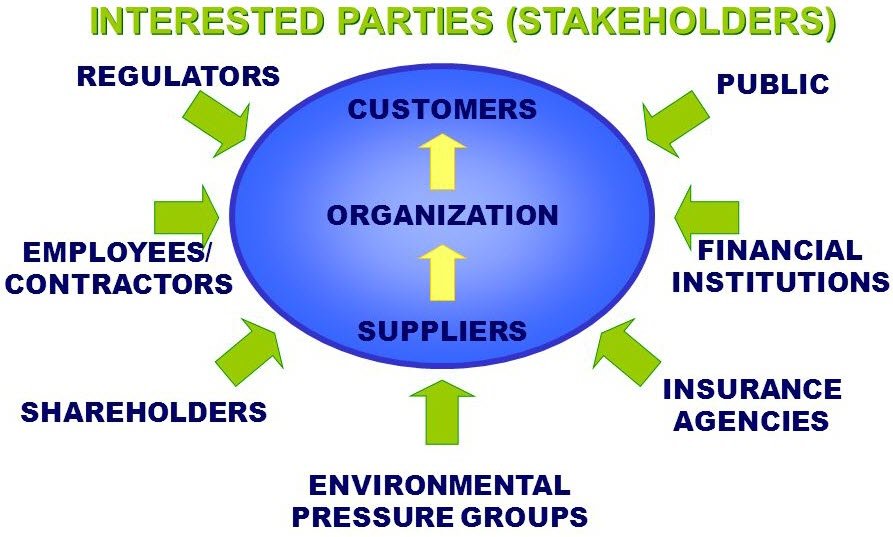EQMS Blog

Defining Needs And Expectations Of ISO 9001 Interested Parties
There is another new requirement for your quality management system (QMS) in ISO 9001:2015, and that is to comprehend the needs and expectations of your interested parties, however what does this mean and how might you do this? Here is a three step procedure to enable you to explore this necessity.
The ISO 9001 Interested Parties
The initial step is to take a look at who are the ISO 9001 interested parties referred to in the standard, it is here referring to people or organisations who will affect your capacity to provide products and services which reliably address the issues of your clients and legal necessities. List all that have an effect on your organisation one by one, such as clients, government organisations, non-government agencies, representatives, shareholders, suppliers, and so forth.
When you have this list, a list of those, who you think could have an impact on your ability to provide your products and services, you can figure out which parties you believe to be the most significant once to your QMS. For example, a non-government organisation that petitions for enhanced safety in hockey might be an interested party in the event that you create hockey cap urging you to go over the legal safety limits, yet not really if you’re manufacturing hockey sticks. Keep in mind; it is for you to figure out who are the applicable interested parties for your QMS.
Example of ISO 9001 Interested Parties
- Customers
- People in an organisation
- Bankers
- Unions
- Society
- Pressure Groups
- Owners
- Providers
- Regulators
- Partners
- Competitors
The Needs & Expectations of the Relevant Interested Parties
For every relevant interested party you have defined, you need to work out what their known needs and expectations are. These needs and expectations could be declared or unspoken, so it is imperative to thoroughly consider in which form each interested party may identify their needs. Below we have defined the areas to look for needs and expectations for some of the ISO 9001 interested parties listed above.
Customers & Suppliers
Contracts and performance specifications is the primary area to look. Different information sources can be included such as client meetings, supplier meeting, returned items, concerns and other complains, warranty information, responses to purchased information. Sometimes you also interact with a client using your products or services, where they can explain what they expect and what they are disappointed with.
Government organisations
What statutory and administrative requirements are relevant to your organisation? Keep in mind, this can include environmental or health & safety legislation to as not meeting this could affect your ability to conveyance on your product and service terms.
Non-government agencies
Are there any industry guidelines or codes of practice for the services or product you are offering? If this is the case, are you committed to execute these?
Shareholders
As the shareholders only are focused on the profit, what QMS system are you implementing to improve this? For example, a cost reduction system or continual improvement program.
Understanding the Needs and Expectation of the Interested Parties
To appreciate how you can best comprehend these needs and expectations, it is useful to take a look at the places in the ISO 9001:2015 standard where the needs and expectations of interested parties are incorporated for consideration. Here are the five fundamental requirements that anticipate you to include the consideration of the needs and expectations of ISO 9001 interested parties:
Scope of QMS
Here you should add the requirements of interested parties for characterizing what your products and services are. For example, are you a widget producer, or are you an automotive widget maker; this information from your interested parties can drive your scope definition.
Quality Policy
These requirements include permitting interested parties access to your quality policy, so you have to decide whether this is appropriate relying upon what the needs and expectations of these interested parties are.
Measurement Traceability
Is measurement traceability a desire for your interested parties? Is it required for your clients, legal reasons or even internal governance reasons? You should comprehend this need to actualize it.
Requirements for Products and Services
When creating, producing and delivering your products and services you should incorporate all those needs and expectations from your interested parties. What are they expecting from your products and services? In what manner will the customers use them? You should comprehend this with a specific end goal to deliver on these needs.
Design and Development
Once more, as in requirements for the products and services, what is expected to plan and build up your products and services? By understanding these expectations you can sufficiently design the products and services expected to address these issues.
If you are considering implementing an ISO 9001 quality management system, then contact us for a free consultation with one of our ISO 9001 consultants to hear how we are able to support you.

Request a free consultation
Contact us to discuss your needs and see how we can support to reach your goal.

Recent posts

In today's digital age, businesses are constantly exposed to various cyber threats. As a result, companies must adopt a proactive approach to cybersecurity to prevent data breaches, theft, and other...

Quality management systems are essential in ensuring that organisations can deliver quality products and services consistently. The International Organisation for Standardization (ISO) developed the ISO 9001 standard to help organisations...

ISO 14001 is a globally recognised standard for environmental management systems (EMS) that helps organisations manage their environmental impact and improve their sustainability performance. Obtaining this certification demonstrates a company's...
Just a Few of Our Clients
Request a Free Consultation
Contact us to discuss your needs and see how we can support to reach your goal.















